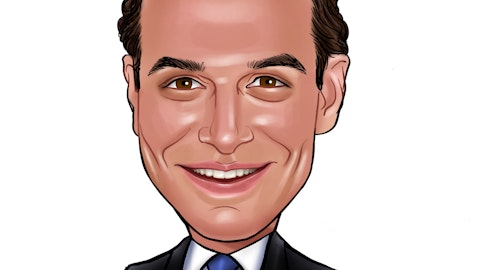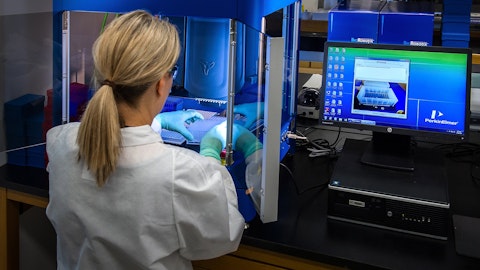Jonathan Neely: Yes, sure. Thanks, Glen. Yes, I think you kind of hit the nail on the head. I think we’ve given you enough pieces to maybe put the math together yourself or yourselves. But obviously, we ended the year with $94 million in cash. As you pointed out, we structured our business to reduce use of cash in 2023, again, while preserving the infrastructure and capability is important to a rapid and successful launch in CS following potential approval. The midpoint of our revenue and operating expense ranges, they imply approximately a $20 million improvement to operating income relative to full-year 2022. And I think the way we’re structured this business, we expect that similar improvement to the use of cash. And so then as a note for folks if you don’t have the press release open or the 10-K opened later on, our use of cash in 2022 was approximately $67 million.
Glen Santangelo : Right. So that — so correct — sort of assuming that burn kind of comes down in the $30 million to $40 million range.
Jonathan Neely: Yes, I mean, I think the kind of the midpoint of the operating expense and revenue view would imply approximately $20 million, if you want to kind of range it out with the high and low ends of those things, it’s probably somewhere between $15 million and $25 million improvement. I think as an organization, we would try to aim for the higher end of that range, not pair up low case revenues with high case operating expenses. So, I think we would strive to be approximately 20%, but maybe a little bit better than 20% a little bit better in 20% within those ranges.
Glen Santangelo : Alright, perfect. Jonathan, that’s fine. Then just sort of as a follow-up. I did want to talk about sort of where that will leave you, right? I mean I think the Company has always been pretty much leaning towards the opportunity to enter into some type of commercial partnership, right, in anticipation of the CS indication. I mean, any thoughts with respect to timing around that? I mean you’re sort of laying out a timeframe for hopefully a PDUFA in mid-December. I mean, have those conversations started? Do you think we could expect to see something in the second half of the year? Or do you think that’s kind of more would come in 2024 post approval?
Ramy Mahmoud: So Glen, I’ll comment on that. So it’s very difficult in advance of reaching an agreement to say exactly when an agreement might be reached. I can say that we have in the past, and I certainly intend right now during 2023 to engage in a variety of conversations with organizations that may have interest in promoting the product into the large audience that were not reaching with our own commercial footprint. Whether those organizations will prove to be interested in closing an arrangement prior to the PDUFA date, whether they may be interested in seeing the PDUFA approval before closing an arrangement and what exactly the terms of such an arrangement might be, those are uncertain. I don’t know the answer to those questions yet. But with regard to whether we’ll be engaged in active conversations during the course of this year, the answer is definitely, yes.
Glen Santangelo : Okay. Thanks.
Operator: Please stand by for our next question. Our next question comes from David Amsellem with Piper Sandler.
David Amsellem : Thanks. So, I guess I’ll just sort of talk to maybe an obvious question, but I think an important one, you’re entertaining a co-promote here. I know that’s something you talked about going back to the IPO, but just given where things are with the business and given the potential challenges regarding interest in owning a piece of the asset here. Why don’t you just entertain a sale of the company? And do you think that may be the better alternative here just given all the moving parts, how do you think about that?
Ramy Mahmoud: So David, I’ll comment on that and then Jonathan I’ll invite you to comment if you have anything to add. So, all of the reasons that you’ve described, David, and others, we are evaluating a wide range of strategic options. And I think sales of the Company is within the range of options that we’re considering, it always has been and it will continue to be. It’s certainly not the only possibility we’re considering. As I said earlier, we are actively planning to engage in conversations about a primary care promotional partnership and plan to do everything necessary to continue to operate the company independently. But in no way does that preclude the possibility of conversations about M&A type transaction either. So we will continue to entertain all strategic options as we go forward through 2023.
David Amsellem : And then as a follow-up, as you look at the launch in CS, you’ve talked about the potential for greater penetration within your existing prescriber base. So, is it fair to say that, that’s where at least early on in the rollout, that’s where most of your growth is going to come from. And if that is certainly the case then, what is the urgency to entertain a primary care partnership ahead of approval or around the approval?
Ramy Mahmoud: So David, the potential for the product, we think, is very substantial within our current sort of commercially contacted our direct selling audience and indirect selling. Our specialty audience has a lot of new potential with the new indication. And we do intend to go after that assertively with our own infrastructure. But that doesn’t mean that there’s not a lot of additional potential outside of the audience that we’re currently calling on. And we really don’t have the resources to go after that, certainly not with a traditional direct selling model. So, it means that if we are able to reach a primary care partnership starting on day one after the approval, there is potential in a very large audience that we’re just not going to be able to efficiently access ourselves.
And primary care partnership would give us a vehicle for being able to increase the potential value available to us and increase the number of patients who are able to be treated. So it would be incremental value, very much worth having for a variety of reasons that we’d like to see. But that doesn’t mean that we’re not going to see substantial incremental value within our current audience. So, I’m not sure though, if I’ve answered your question, David. Did that address what you asked?
David Amsellem : It did. I guess I’m just struggling with the urgency to find a primary care partner. I mean don’t you call on a certain basket of high-volume general practitioners already? And if so, how many do you call on?
Ramy Mahmoud: David, I think it’s appropriate for us to have a sense of urgency around finding a primary care partner. And that’s not because there’s not a lot of potential in our current audience, there is. But the sooner we can get a primary care partner, the sooner we can access an otherwise untapped large potential audience. And while it’s true that we do have a small number of, I’ll call it, a specialist like primary care physicians in our called on universe. It’s a very small number in comparison to the number of primary care physicians that one might ideally choose to engage if you had a primary care promotional infrastructure. What’s our current number right now?
Jonathan Neely: Yes. I mean, David, just for a sense of scale, I think when you think about the number of specialty like primary care physicians and our current call on the universe we’re talking about a number that’s a few thousand as opposed to when you look at the broader opportunity in primary care, I think historically, we’ve looked at — there’s potentially an audience of somewhere around 50,000 physicians who are kind of the higher-value prescribers in the chronic sinusitis space. And so it’s just a completely different order of magnitude in terms of the number of physicians that somebody with appropriate infrastructure that would be leverageable there’s opportunity could reach if we were to partner with them.
David Amsellem : Okay. Got it. Thank you.
Operator: I show no further questions at this time. I would now like to turn the conference back to Ramy for closing remarks.
Ramy Mahmoud: I’d like to thank you all very much for joining us this morning for our review of the full-year performance in 2022 and our forward look into what we expect may be coming in 2023. And we look forward to talking to you again in a few months with our first quarter results. Everyone have a wonderful day.
Operator: This concludes today’s conference call. Thank you for participating. You may now disconnect.
Follow Optinose Inc. (NASDAQ:OPTN)
Follow Optinose Inc. (NASDAQ:OPTN)
Receive real-time insider trading and news alerts



